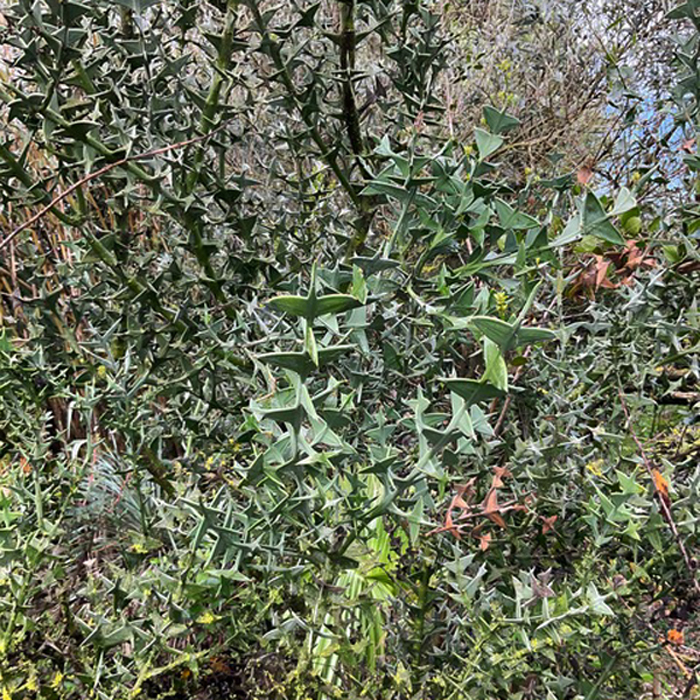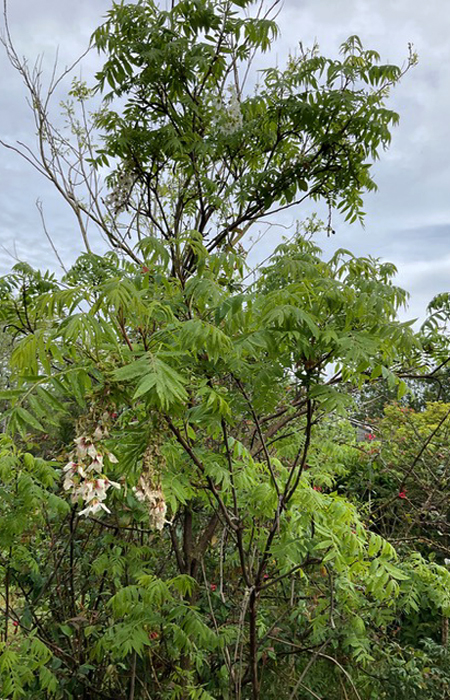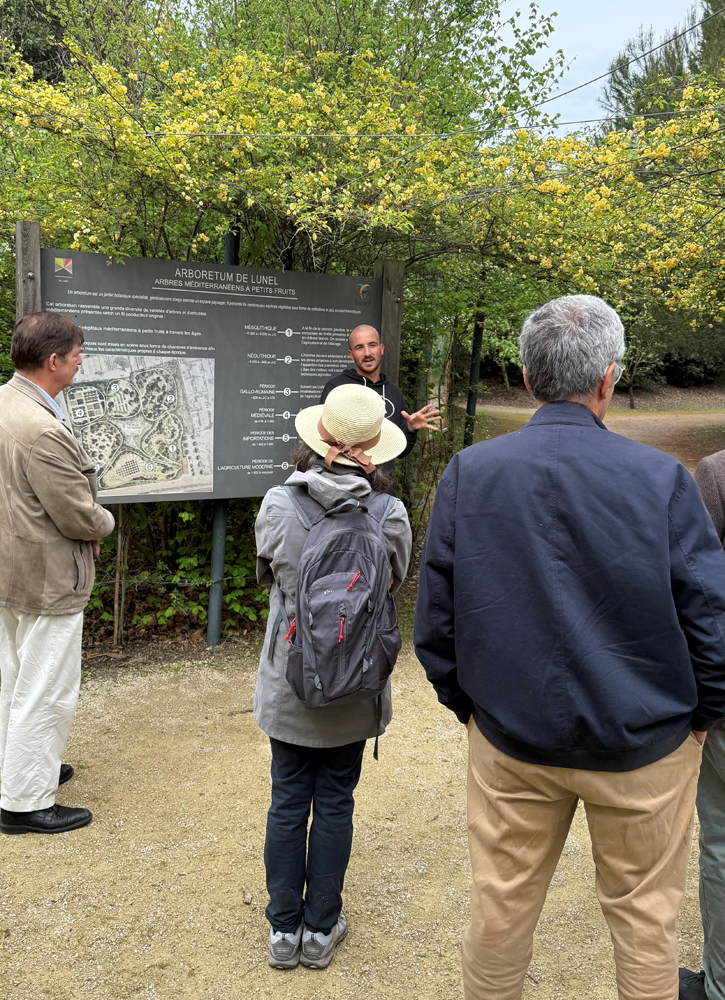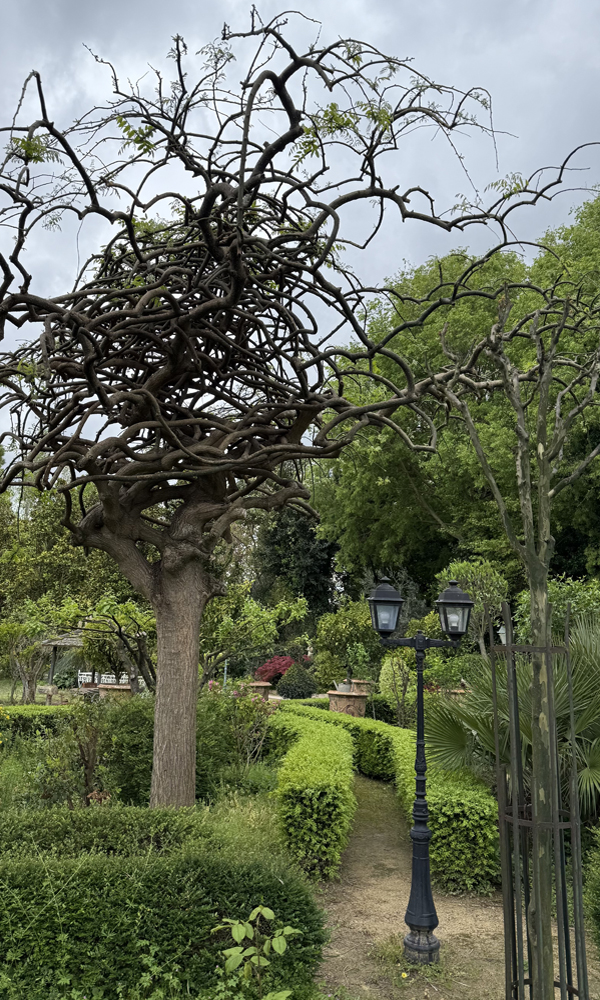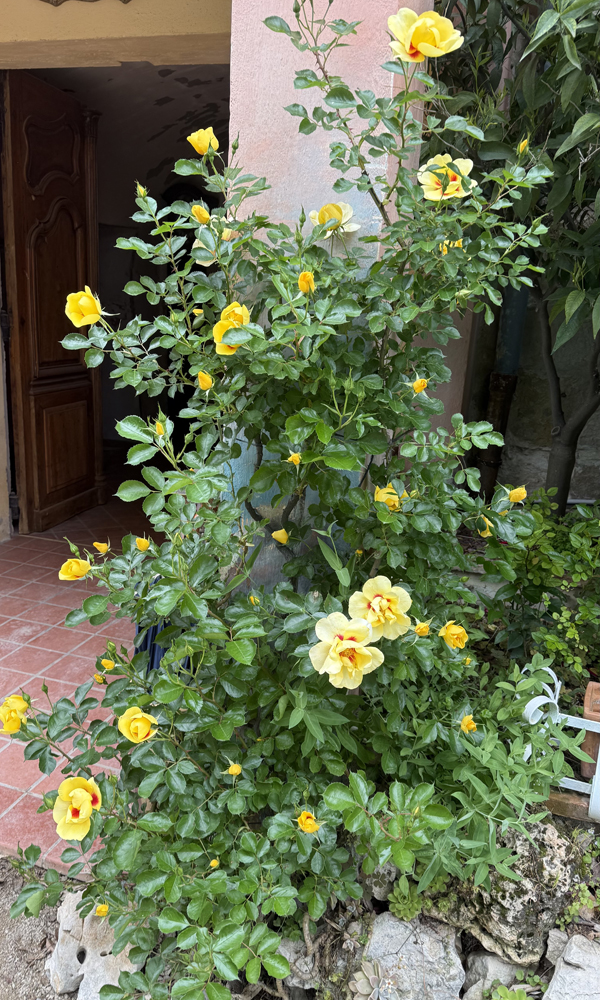Visits to Le Jardin d’Henry, the Lunel Arboretum and Le Mas de Chambon
Visites au Jardin d’Henry, à l’Arboretum de Lunel et au Mas de Chambon
April / avril 2025
Click on the images to enlarge them / Cliquez sur les images pour les agrandir
Le Jardin d’Henry
The first of our Lunel Gardens was that of Henry Nardy, a renowned plantsman and nurseryman whom Chantal has known for some 40 years, originally travelling from Paris to get her plants from him.
Le premier des jardins visités à Lunel fut celui d’Henry Nardy, un pépiniériste et passionné de plantes renommé, que Chantal connaît depuis près de 40 ans, se rendant de Paris pour acheter ses plantes chez lui.
It is a total delight – Henry lives on the premises, so it is a really personal and eclectic collection, with some quirky found art put together by Henry, including a ‘tree’ of old galvanised watering cans, all to the music of nightingales, tree frogs and the sociable, and quite loud, donkey mare, Renoncule.
Ce jardin est un véritable enchantement – Henry vit sur place, ce qui donne au lieu un caractère très personnel et éclectique, ponctué de touches artistiques insolites créées par Henry lui-même, comme cet « arbre » fait d’arrosoirs en zinc, le tout rythmé par le chant des rossignols, des rainettes et d’une ânesse sociable – et plutôt bruyante – nommée Renoncule.
We wandered past many different trees, shrubs and flowers, some exotic, others not so much, but all happily co-existing in Henry’s rich soil, with a good high water table. Henry says that the temperatures can drop to -11°C, but there is a large glass house for more tender subjects, and other plants seem to flourish in this sheltered spot.
Nous avons déambulé parmi une incroyable variété d’arbres, d’arbustes et de fleurs, certains exotiques, d’autres plus familiers, mais tous prospérant harmonieusement dans la terre fertile d’Henry, avec une nappe phréatique proche de la surface. Henry nous confie que les températures peuvent descendre jusqu’à -11°C, mais une grande serre permet d’abriter les plantes les plus fragiles, tandis que d’autres s’épanouissent dans ce site naturellement protégé.
Highlights were Protea cyanoides, small as yet, but well-established and on the point of flowering, and the South American natives Cascabela thevetia (Yellow oleander), Colletia paradoxa and Schinus molle(Peruvian pepper), both male and female.
Parmi les moments forts de la visite : un Protea cynaroides, encore petit mais bien établi et prêt à fleurir ; des espèces d’Amérique du Sud comme le Cascabela thevetia (Laurier jaune), Colletia paradoxa (Colletie croisette), Schinus molle (Poivrier rose), en exemplaires mâle et femelle.
We were also delighted by Cercis siliquastrum f. alba, a lovely white form of the Judas Tree, Xanthoceras sorbifolium with beautiful racemes of white flowers, Westringia fruticosa,Grevillea rosmarinifoliaandsome splendid and old established Yucca filifera.
Nous avons également été séduits par le Cercis siliquastrumf.alba, une magnifique forme blanche de l’arbre de Judée, le Xanthoceras sorbifolium avec ses superbes grappes de fleurs blanches, le Westringia fruticosa, la Grevillea rosmarinifolia, ainsi que de splendides et anciens Yucca filifera.
No garden (particularly Henry’s) being complete without some useful consumables, we found, among others, Smyrnium olusatrum (aka maceron, the forerunner of celery), Zanthoxylum armatum (Szechuan pepper) and an old fashioned favourite, Ziziphus jujuba(jujubier).
Aucun jardin (surtout pas celui d’Henry) ne serait complet sans quelques plantes comestibles utiles. Nous avons ainsi trouvé, entre autres trésors, le Smyrnium olusatrum (appelé maceron, ancêtre du céleri), le Zanthoxylum armatum (poivrier de Sichuan), et un classique d’antan, le Ziziphus jujuba (jujubier).
Henry, with a little help from Chantal, was a charming and welcoming guide to his many plants, and we had a great start to an altogether intriguing day.
Henry, aidé un peu par Chantal, fut un hôte charmant et accueillant pour nous faire découvrir sa vaste collection botanique – une excellente entrée en matière pour une journée tout à fait passionnante.
Text and photos: Sandra Cooper
L’Arboretum de Lunel
Our second visit of the day was to the Lunel arboretum. This was established fairly recently (2013) but, because of staff shortages, it is only open to groups. Nevertheless, our two successive groups were welcomed by a member of staff from the tourist office, who very competently showed us around.
Notre deuxième visite de la journée a été celle de l’Arboretum de Lunel. Il s’agit d’un endroit assez récent (2013) qui, par manque de personnel, n’accueille que des groupes. Néanmoins, nous avons été accueillis en deux groupes successifs par un employé de l’office du tourisme qui nous a fait visiter avec beaucoup de compétence.
The arboretum covers an area of two hectares, and around 130 different species are presented across six distinct spaces. Each of these six ‘rooms’ follows the development of human cultures and their way of life, from the Palaeolithic to the present day. The park is well laid out and each room is entered through a pergola covered in Rosa banksiae f. lutea, in flower at the time of our visit.
L’Arboretum couvre une superficie de 2 hectares, avec environ 130 espèces différentes présentées à travers 6 espaces distincts. Chacune de ces 6 « salles » suit l’évolution des cultures humaines et de leur mode de vie, du paléolithique à nos jours. Le parc était bien aménagé et l’on entrait dans chaque salle par une pergola couverte de Rosa banksiae f. lutea en fleurs.
It was fascinating to get a feel of how the landscape has evolved under the influence of mankind, particularly, of course, food production, and then, more recently, the importing of plant varieties from all parts of the globe and finally the impact of modern intensive agriculture – a story told through the landscape of trees.
Il était fascinant de voir comment le paysage a évolué sous l’influence de l’homme, en particulier, bien sûr, pour la production alimentaire, puis, plus récemment, par l’importation de variétés de plantes de toutes les parties du globe et enfin par l’impact de l’agriculture intensive moderne – une histoire racontée dans le paysage d’arbres.
The six rooms covered different eras:
Les six salles couvrant l’époques étaient :
1.The Mesolithic period: this room represents the forest environment following the final period of glaciation. The vegetation was composed of dense primary forest, the era of the chêne blanc and chêne vert.
1. Le Mésolithique : cette salle représente le milieu forestier suivant la dernière glaciation. La végétation était composée de forêt primaire dense, époque du chêne blanc et du chêne vert.
2. The Neolithic period: a period marked by the triple domestication of plants, animals, and microbes, which enabled the transformation and preservation of new foods. The agricultural and pastoral practices of the time led to the disappearance of the primary forest, replaced by scrubland.
2. Le Néolithique : une période marquée par la triple domestication des plantes, des animaux et des microbes, qui a permis la transformation et la conservation de nouveaux aliments. Les pratiques agricoles et pastorales de l’époque ont entraîné la disparition de la forêt primaire, remplacée par la garrigue.
3. The Gallo-Roman period: The 5th century BC was marked by a marked cooling in Europe. Driven by these new climatic conditions, the Celts, a people from the regions of present-day Poland and Germany, settled in this region. Fruit trees, such as figs and vines were cultivated.
3. L’époque gallo-romaine : le Ve siècle avant J.-C. a été marqué par un refroidissement marqué en Europe. Poussés par ces nouvelles conditions climatiques, un peuple originaire des régions de la Pologne et de la Germanie actuelles, les Celtes, s’est installé dans la région. Des arbres fruitiers, tels que le figuier et la vigne, étaient cultivés à cette époque.
4. The Middle Ages: In the 5th century AD, the region experienced a succession of invasions: Visigoths, Arabs, and Franks, bringing their share of destruction. This period was marked by the return of the forest. People organised gardens and vegetable plots. The garden displayed interesting raised beds in wattle containers and dry stone walls.
4. Le Moyen Âge : au Ve siècle après J.-C., la région a connu une succession d’invasions : Wisigoths, Arabes et Francs, apportant leur lot de destructions. Cette période fut marquée par le retour de la forêt. Les humains organisèrent des jardins et des potagers. Nous avons pu observer ici des massifs surélevés très intéressants, construits dans des bacs en clayonnage, et des murets en pierres sèches.
5. Trade between East and West allowed the spread of numerous animal and plant species. From 1492 onwards, following the discovery of the Americas, the fields, orchards, and gardens of Europe were enriched by exotic plants, including the agave.
5. Le commerce entre l’Orient et l’Occident permit la propagation de nombreuses espèces animales et végétales. À partir de 1492, la découverte des Amériques enrichit encore les champs, les vergers et les jardins d’Europe. C’est ici que nous fûmes initiés à l’agave.
6. The era of modern agriculture: Modern agricultural practices put a stop to periods of famine in Europe; however questions are now being raised about its sustainability, and the impoverishment of crop diversity. The orchard in this section offers a selection of different varieties which illustrate the diversity of our tree heritage.
6. L’ère de l’agriculture moderne : L’agriculture moderne a mis fin aux périodes de famine en Europe, mais elle soulève aujourd’hui des questions quant à sa durabilité et à l’appauvrissement de la diversité des cultures. Le verger présenté dans cette section propose une sélection de différentes variétés illustrant la diversité du patrimoine arboricole.
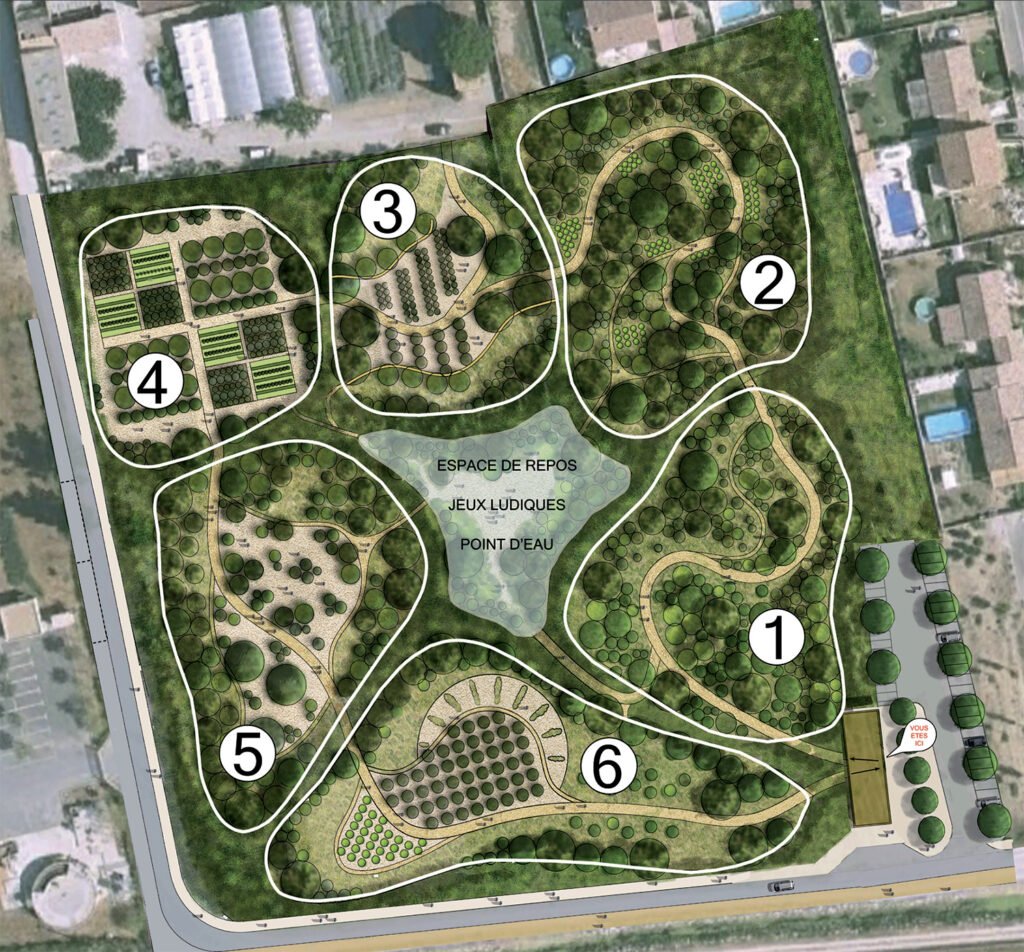
Texte: Bernadette Schutte
Photos : Jacqueline Potter
Le Mas de Chambon : un jardin de passion
Mr. Armand Wizenberg, the owner, welcomed us with great generosity. A retired antiques dealer, he acquired this dilapidated old farmhouse in 1998 and has been patiently restoring it ever since. With the same passion and remarkable perseverance, he set about reviving a vast, 1.5-hectare garden. Though not a trained gardener, he has, over time, learned from his mistakes and shaped the space with love and humility. The result is a superb, harmonious garden that feels as though it has always been part of the landscape.
M. Armand Wizenberg, le propriétaire, nous a accueillis avec une grande générosité. Antiquaire à la retraite, il a acquis ce vieux mas en ruine en 1998, qu’il a patiemment restauré depuis. Avec la même passion et une persévérance remarquable, il a entrepris de redonner vie à un vaste jardin d’1,5 hectare. Bien qu’il ne soit pas jardinier de formation, il a su, au fil du temps, apprendre de ses erreurs et façonner ce lieu vivant avec amour et humilité. Le résultat est un jardin superbe, harmonieux, qui semble avoir toujours fait partie du paysage.
The garden contains a few century-old trees, but all the rest has been carefully planted, mostly with Mediterranean species. The house is approached along an entrance way bordered by magnolias. To the right lies an elegant water feature, surrounded by a variety of roses and other Mediterranean plants. More recently, an olive grove has also been planted. At the rear of the Mas, a traditional hydraulic system known as a pouzarenque is currently being restored.
Le jardin conserve quelques arbres centenaires. Le reste a été soigneusement planté d’essences majoritairement méditerranéennes. À l’avant de la maison, on entre par une magnifique allée bordée de magnolias. Sur la droite, on trouve une élégante pièce d’eau, divers rosiers et d’autres plantes typiques du sud. Plus récemment, une oliveraie a également été plantée. À l’arrière du mas, un ancien « pouzarenque » – mécanisme hydraulique traditionnel – est en cours de restauration.French text
The large vegetable garden offers a fine variety of vegetables and aromatic herbs. A small poultry yard completes the picture. On the façade of the house and on arches placed throughout the garden, beautiful climbing plants flourish—among them, a Hulthemia rose that particularly drew the group’s attention. Their fascinating history captivated the audience. An article dedicated to these roses is available in the ‘Plants’ section of the website.
Le grand potager offre une belle diversité de légumes et d’herbes aromatiques. Une petite basse-cour complète ce tableau. Sur la façade du mas et sur les arches disposées dans le jardin s’épanouissent de magnifiques plantes grimpantes, parmi lesquelles un rosier Hulthemia a particulièrement attiré l’attention du groupe. Leur histoire fascinante a captivé l’auditoire. Un article dédié à ces rosiers se trouve dans la rubrique « plantes » du site web.
Text and photos: Jacqueline Potter
![]()


